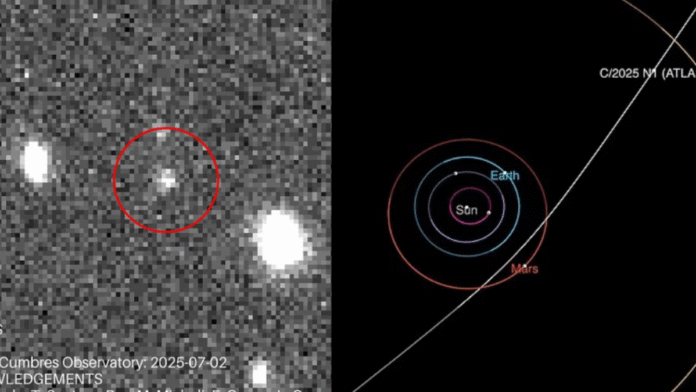Key Point Summary – Mysterious Interstellar Object
- 3I/ATLAS is an interstellar object flying toward the sun
- Detected on July 1, it’s moving at 135,000 mph
- Some scientists believe it could be artificially lit
- Harvard’s Avi Loeb suggests alien origins can’t be ruled out
- NASA and ESA call it an interstellar comet
- It poses no threat, will pass 150 million miles from Earth
- Best observations may come in December after it reemerged
A Visitor From Another Star
A mysterious object has stunned astronomers and sparked wild theories, including the possibility of an alien spacecraft. Named 3I/ATLAS, the object was first spotted by NASA’s ATLAS system on July 1. It has now been confirmed as only the third interstellar object ever detected entering our solar system.
The European Space Agency captured the first video of the visitor using a powerful telescope in Hawaii. The object appears incredibly bright, hinting at either a massive size or unusual illumination.
At an astonishing 135,000 miles per hour, the 12-mile-long object is racing toward the sun. It will pass just inside the orbit of Mars on October 30—but scientists say there’s no threat to Earth.
Alien Theories Spark Fierce Debate
While most experts are calling 3I/ATLAS an interstellar comet, not everyone agrees.
Harvard astrophysicist Professor Avi Loeb, known for his controversial theories about alien probes, believes something unusual might be going on.
“If it is not a comet, then its large brightness would be a big surprise and potentially signal a non-natural origin,” Loeb said, suggesting artificial light could be responsible.
He previously stirred headlines by suggesting that 2017’s ‘Oumuamua — another interstellar object — might have been alien in nature. His reasoning? It moved strangely and had no visible tail or evaporation.
Loeb now believes 3I/ATLAS deserves the same scrutiny.
NASA and ESA Say: It’s a Comet
Despite the theories, both NASA and the ESA say the evidence points to a comet.
The object has a coma, a bright envelope of gas and dust, which forms when a comet heats up near the sun. Scientists say this coma is what makes the object look so bright.
Astronomer Dr. Mark Norris confirmed: “If there’s a coma, it by definition is a comet. As it gets closer to the sun, we should see more material outgassing.”
For now, NASA classifies it as an interstellar comet, meaning it formed in another star system and got ejected, eventually finding its way here.
Still, Experts Say ‘Don’t Rule Anything Out’
Others urge caution before drawing conclusions. Professor Michael Garrett, Director at Jodrell Bank Centre for Astrophysics, agrees that while it’s probably a comet, the alien hypothesis should still be investigated.
“Who knows—it could be,” Garrett said. “We learn more every time one of these objects appears. It’s unlikely, but we must test all hypotheses.”
He stressed that no direct evidence of alien origin exists, but the scientific community should remain open.
A Growing Obsession With Interstellar Visitors
3I/ATLAS marks the third known visitor from beyond the stars. ‘Oumuamua was the first, followed by comet Borisov in 2019. In each case, astronomers scrambled to observe the objects before they vanished into the cosmic void.
Now, amateur and professional astronomers alike are racing to gather as much data on 3I/ATLAS as possible before it disappears.
Through a process called precovery, older telescope data is being re-analyzed to track the object’s movements and confirm its origin.
Thanks to these efforts, scientists verified that 3I/ATLAS came from outside our solar system, likely flung away from its home star system millions of years ago.
It Will Vanish Behind The Sun Soon
Currently, the object is 420 million miles from Earth. At its closest, it will come within 150 million miles—about the same distance as Earth to the sun. However, when that moment arrives in late October, it will be positioned behind the sun, making observation difficult.
Scientists hope that once it reemerges in December, it will still be bright enough to study. They expect more data will help clarify whether it behaves like a traditional comet—or something far stranger.
Until then, the debate continues.
Unlikely To Be Aliens—But Still Important
While the alien spacecraft theory makes headlines, most scientists emphasize the importance of studying these objects regardless of origin. Each new interstellar body gives insight into planetary systems far beyond our own.
Even if 3I/ATLAS is just a very cold, very old ball of gas and dust, its path through our solar system is rare—and worth watching.
As Dr. Norris puts it: “We don’t know much about these objects. That’s why every new one is an opportunity.”
So is it a comet? Or something more? The cameras are rolling, the data is coming in—and for now, the solar system holds its breath.




